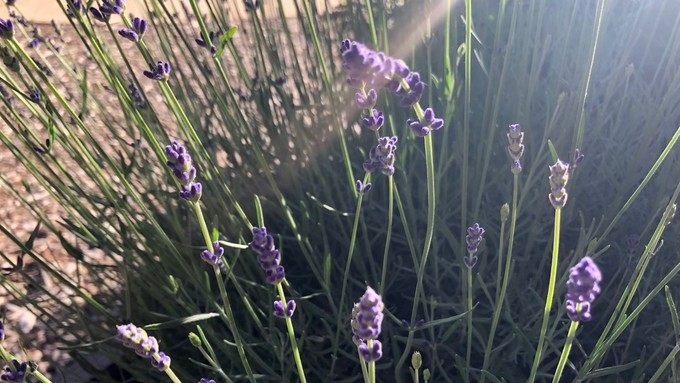
Free workshop covers how to grow, harvest and use this popular herb

Lavender prefers a bright, dry spot with relatively poor soil -- and good drainage. Kathy Morrison
Have California gardeners adopted a Mediterranean mindset? Using Google searches as a measure, a study by horticultural guide Gardening Chores concluded that lavender is California’s favorite flower.
Not only is it California’s top searched-for flower, but No. 1 in 41 states plus the District of Columbia, says the report.
Second among searched-for flowers (coupled with the phrase “how to grow”) in California was sunflower, followed by rose, peony and hydrangea.
Why lavender? It’s more than just a pretty flower, explained horticulture expert Amber Noyes, Gardening Chores executive editor, who is based in San Mateo.
“Lavender provides many benefits to the area in which it is grown and can thrive both outdoors and indoors with proper care,” she said in the report’s announcement. “From its widely acknowledged pleasant fragrance to its beautiful violet flowers, it provides a welcoming space for pollinators, and acts as an excellent repellent of nuisance garden insects, such as mosquitoes and ticks.
“With this in mind, it stands to reason that lavender would be the most popular flower in California. It will be particularly interesting to see whether the most-searched-for flowers are also the most frequently grown by those cultivating their gardens this summer.”
A lot of those “how to grow” searches may have come due to struggling lavender plants. Lavender likes a challenge. It’s usually killed by kindness. Instead of rich soil and lots of irrigation, it wants a bright, dry spot with relatively poor soil. It demands good drainage.
Native to the Mediterranean region and drought-tolerant, the lavender genus includes 47 species and more than 450 varieties. Lavender is a favorite with bees and a must for pollinator gardens.
Besides attracting beneficial insects, the flowers have culinary and medicinal uses. Their fragrance promotes relaxation.
Learn more in a free workshop at 9 a.m. Wednesday, June 14, at the Cameron Park Community Center. Presented by the El Dorado County master gardeners, “All About Lavender” is just that – an information-packed three-hour session about how to grow, harvest and use this versatile herb.
Master gardeners Donna Marshall and Muriel Stephenson will teach the lavender basics and a lot more. The class includes how to propagate lavender, and everyone will leave with their own cuttings to root.
No advance registration is necessary. Cameron Park Community Center is located at 2502 Country Club Drive, Cameron Park.
Questions? Email mgeldorado@ucanr.edu.
Details: https://mgeldorado.ucanr.edu/
Comments
0 comments have been posted.Sacramento Digs Gardening to your inbox.
Sites We Like
Garden Checklist for week of April 21
This week there’s plenty to keep gardeners busy. With no rain in the immediate forecast, remember to irrigate any new transplants.
* Weed, weed, weed! Get them before they flower and go to seed.
* April is the last chance to plant citrus trees such as dwarf orange, lemon and kumquat. These trees also look good in landscaping and provide fresh fruit in winter.
* Smell orange blossoms? Feed citrus trees with a low dose of balanced fertilizer (such as 10-10-10) during bloom to help set fruit. Keep an eye out for ants.
* Apply slow-release fertilizer to the lawn.
* Thoroughly clean debris from the bottom of outdoor ponds or fountains.
* Spring brings a flush of rapid growth, and that means your garden is really hungry. Feed shrubs and trees with a slow-release fertilizer. Or mulch with a 1-inch layer of compost.
* Azaleas and camellias looking a little yellow? If leaves are turning yellow between the veins, give them a boost with chelated iron.
* Trim dead flowers but not leaves from spring-flowering bulbs such as daffodils and tulips. Those leaves gather energy to create next year's flowers. Also, give the bulbs a fertilizer boost after bloom.
* Pinch chrysanthemums back to 12 inches for fall flowers. Cut old stems to the ground.
* Mulch around plants to conserve moisture and control weeds.
* From seed, plant beans, beets, cantaloupes, carrots, corn, cucumbers, melons, radishes and squash.
* Plant onion sets.
* In the flower garden, plant seeds for asters, cosmos, celosia, marigolds, salvia, sunflowers and zinnias.
* Transplant petunias, zinnias, geraniums and other summer bloomers.
* Plant perennials and dahlia tubers for summer bloom.
* Mid to late April is about the last chance to plant summer bulbs, such as gladiolus and tuberous begonias.
* Transplant lettuce seedlings. Choose varieties that mature quickly such as loose leaf.